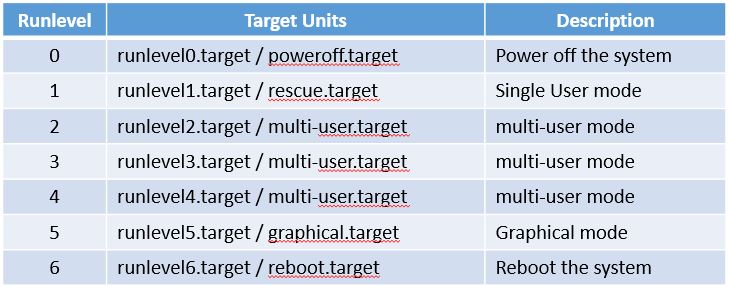System Services and Runlevels
System Services and Runlevels
System Services
Systemd is a system and service manager for Linux Operating
System.
Systemd is designed to work with SysV init scripts, and have
some features like start up of services on boot, on demand etc.
You can easily stop, start and check any service status of
Linux Operating System.
Systemd has replaced init from Redhat 7.
The SysV init is a process used by RHEL to control which
software the init command launches or shuts off on a given
runlevel.
Each runlevel has its directory in /etc/ as “/etc/rcX.d/” and
has symlinks in /etc/init.d/. You can view scripts using
“ls –l /etc/rc0.d/” etc.
Most used command line parameters for init scripts.
start – start the service.
stop – stop the service.
status – check status of service stopped or running.
relaod – reload changed configuration.
restart – retstart your service.
Example:
# systemctl status sshd (sshd is service name, It will give you status. You can use above parameters as per requirement) Runlevels
A runlevel is a way of operation of Linux OS where it uses SysV
init scripts.
You can say it is a state of machine after boot.

Some Important commands related to runlevels
# ls /lib/systemd/system/runlevel*target –l (To view all runlevels link path)
# ln -sf /lib/systemd/system/runlevel5.target /etc/systemd/system/default.target (It will change default runlevel to runlevel 5, a reboot is required for that)
# systemctl get-default (To check current runlevel)
# systemctl set-default multi-user.target (It will change default runlevel to multi-user, a reboot is required for that and after reboot you can check default using above command)
# systemctl isolate multi-user.target (You can switch runlevel with command line)

Related
Loading repositories and latest updates...
Recent Posts
Recent Blog
- Tanisha Yirawala on Difference between Connection-oriented protocols vs Connectionless Protocols
- OlpWriple on Installation of Linux Operating System (Red Hat 8) in VMWare Workstation
- Berenice Saenz on Difference between Connection-oriented protocols vs Connectionless Protocols
- Chloe Adams on Difference between Connection-oriented protocols vs Connectionless Protocols
- Taylor Swift on Difference between Connection-oriented protocols vs Connectionless Protocols
Interview Q&A
- May 2025
- March 2025
- November 2024
- October 2024
- September 2024
- July 2024
- June 2024
- May 2024
- March 2024
- February 2024
- January 2024
- November 2023
- October 2023
- September 2023
- August 2023
- July 2023
- April 2023
- March 2023
- January 2023
- December 2022
- November 2022
- October 2022
- September 2022
- August 2022
- May 2022
- April 2022
- March 2022
- February 2022
- January 2022
- November 2021
- September 2021
- August 2021
- July 2021
- June 2021
 Visit My GitHub VARELITE
Visit My GitHub VARELITE